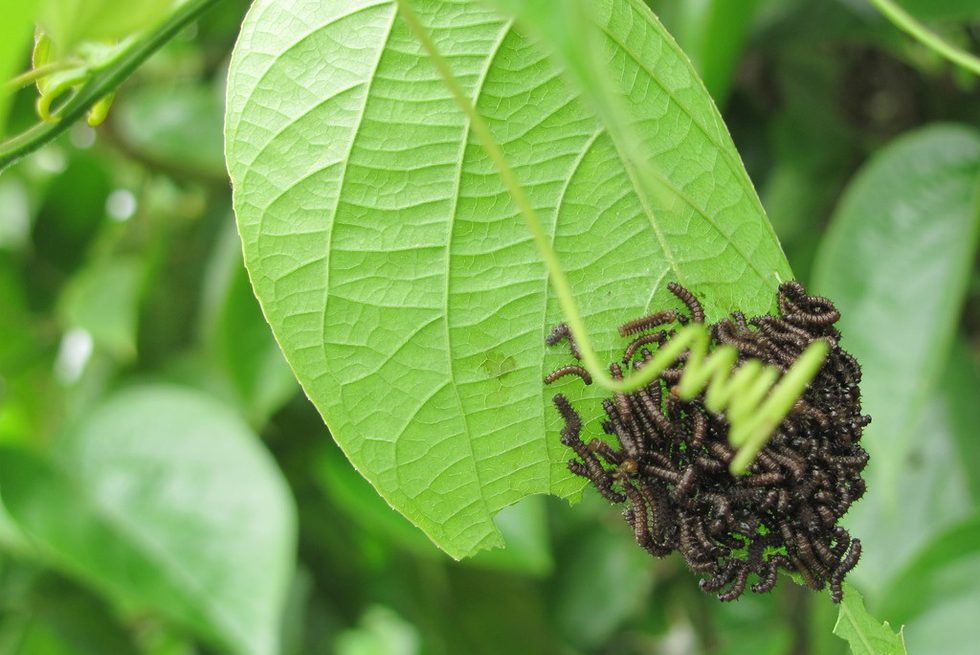
This post builds on the research article “Decomposition as Life Politics: Soils, Selva, and Small Farmers under the Gun of the U.S.–Colombia War on Drugs,” which was published in the February 2016 issue of the Society’s peer-reviewed journal, Cultural Anthropology.
Julia Sizek: I wanted to start this interview with the first photo that appears in your article, where we see a house almost entirely hidden by the selva. In the article, you talk about how life carves out space for itself in the midst of a war against it, even if this life is precarious, fragile, or vulnerable. How does this form of vulnerable life differ from other forms of life being discussed right now, particularly resilient or enduring forms?
Kristina Lyons: Aguantar is the Colombian Spanish word that most closely translates to the English phrase “to endure.” People often joke darkly that they are expertos en aguantar [experts in enduring]. It can mean to hold on or hold out, to put up with, to withstand, and to bear. The popular expression “no aguanta” is an abbreviated way to say that something or someone is intolerable and should not be stomached. The form of life I attempt to articulate holds in tension a delicate balance between opposing, aguantando, and transforming. In other words, opposing intolerable life conditions, aguantando, or carrying on within these conditions and actualizing alternatives to the very conditions that make some lives and ecologies flourish at the expense of making others endure.
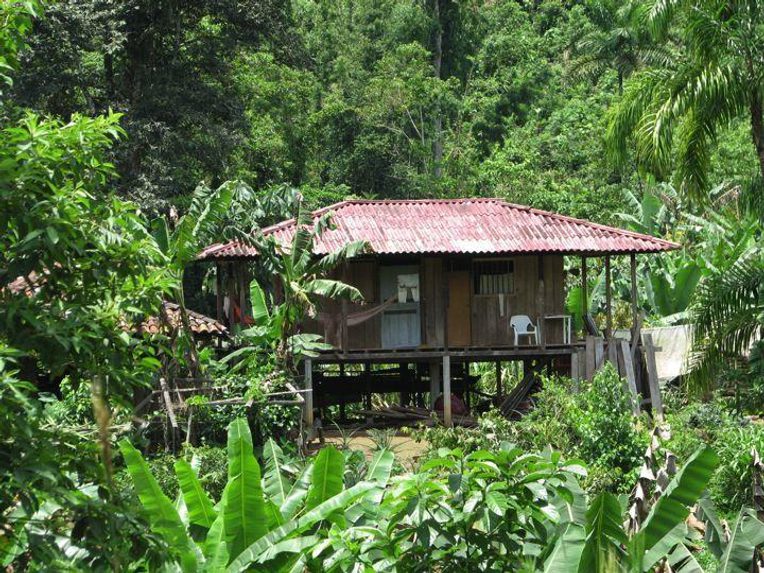
Propositional rage is one way that regional social movements characterize their political action. This is a resistance that is not only denunciatory. It is fueled by anger that opposes by becoming generative and transformative in its aspirations. When thinking about the way life is rendered vulnerable in Putumayo it helped me to think with the temporalities and materiality of hojarasca, its sinking in—decomposing into—the thickness of a present filled with emergent potentialities and actualizations that may become frustrated, resurge, and enfold into one another again. This relates to what I call a robust fragility, which potentiates tentative forms of socioecological repair and which troubles commonsense, reductionist, and stigmatizing connotations of precarity and debility.
While I find the concept of ecological resilience useful to think with when it references the successional life of forests, for example, resilience is a buzzword that now proliferates across many different conversations and agendas: sustainable development, climate geoengineering, flexible forms of capitalist labor, disaster management, and planetary modes of surviving climate change that may or may not imply limiting economic growth, just to name a few examples. I worry that resilience can be imbued with the dangerous assumption that life has the ability to simply “bounce back” even when acknowledging the permanence of altered conditions (see Michelle Murphy’s recent work). While a hopeful and capacious concept, it might not stay with the trouble, to borrow a phrase from Donna Haraway, of the violence, irreparable loss, and ongoing impunity that makes resilience itself a necessity and/or obliged possibility for some forms of life and not others. Anna Tsing (2015, 179) proposes the word resurgence to articulate “the force of the life of a forest, its ability to spread its roots and runners to reclaim places that have been deforested.” The ecological relationality of the selva life and death I talk about depends upon sinking into this deforestation, into the wound itself.
JS: Can you discuss how your research relates to political concerns in the region?
KL: I first learned of the impacts of U.S.-financed aerial fumigation operations in southern Colombia when I worked on a project with La Fundación Regional de Asesoría en Derechos Humanos (INREDH), an NGO that was researching the situation of Colombian refugees not granted official refugee status by the UNHCR process in Ecuador. Many of these individuals had been displaced due to aerial aspersion and were subsequently disqualified for refugee status, because eradication operations are not considered to be a form of direct violence. This ruling perpetuates and is informed by the geopolitically enforced criminalization of rural populations that live in coca-growing regions.
During the first years of my doctoral work, I also collaborated with two NGOs based out of Bogotá, which engage in U.S. policy watch and human rights work in Putumayo. It was during one of these trips that I had the good fortune to meet Heraldo Vallejo, a Putumayo-born animal husbandry technician and farmer, and after walking around La Hojarasca together he invited me visit his farm school on the outskirts of Mocoa. As I briefly recount in the article, the more time I spent with the networks of farmers I met while accompanying Heraldo and the Mesa Regional de Organizaciones Sociales, the more they taught me that violence was not the only story to be told. I was obliged to turn my attention away from what was raining down on them from crop dusters in the sky to the kinds of propositional life-making processes being actualized in the midst of poisoned ecologies. It was this shift that pushed me to think with soils—all that composes and decomposes them—and to follow human-soil relations across laboratories, greenhouses, gardens, and forests in the capital city of Bogotá and the southwestern Amazon. It was also when I began what has evolved into an almost decade-long conversation with Heraldo, Nelso, Elva, and other friends and interlocutors in the Andean-Amazonian foothills. With Marisol de la Cadena and other wonderful teachers at the University of California, Davis, I learned that ethnographic conceptualization is a product of the inseparable weaving of the empirical and the conceptual.
After I finished my PhD, a generous Engaged Anthropology Grant from the Wenner-Gren Foundation allowed me to return to Putumayo, where I accompanied rural social movements during the National Agrarian and Popular Strike in 2013 and 2014. I was invited to join their technical team during strike negotiations with the government and to facilitate popular education workshops between different sectors in the department. The idea for the film project, Cultivando un Bien Vivir en la Amazonia, emerged during the strike. In conversation with Heraldo and groups of farmers that had gathered at different nodes of mobilization in Villagarzón, Putumayo, we imagined ways that alternative selva-based agricultural technical assistance could reach the remote, rural areas where many of them live. The proposal to produce a farmer-to-farmer documentary film series grew out of this conversation. I was able to obtain funding for the project when my dissertation was passed on to the Cultural Division of the Bank of the Republic of Colombia by a former student. Heraldo, Nelso, Elva, and I worked on the scripts. A friend, Ricardo Velasco, who was finishing a Master’s in Social Documentation at the University of California, Santa Cruz, joined us in Putumayo to do the filming, and then he and I worked on editing the material in conversation with Heraldo, Nelso, Elva, and the Mesa Regional.
JS: The emphasis of the film series is on the ways in which autonomy over one’s own food sources is akin to national sovereignty. Can you discuss how the food sovereignty movement relates to political sovereignty in this region? How does this idea of sovereignty relate to the idea of buen vivir?
KL: Over the last thirty years, commercial coca production, as well as the export-oriented alternative development programs meant to substitute for illicit crops, have largely displaced food production in the region. In addition, aerial fumigation operations destroyed enormous quantities of subsistence crops provoking humanitarian crisis. Monoculture coca initiated the arrival of agrichemicals to the territory and led to a reduction in the diversity of seeds being sown. This altered the variety of local plants, trees, recipes, and eating practices throughout much of Putumayo.
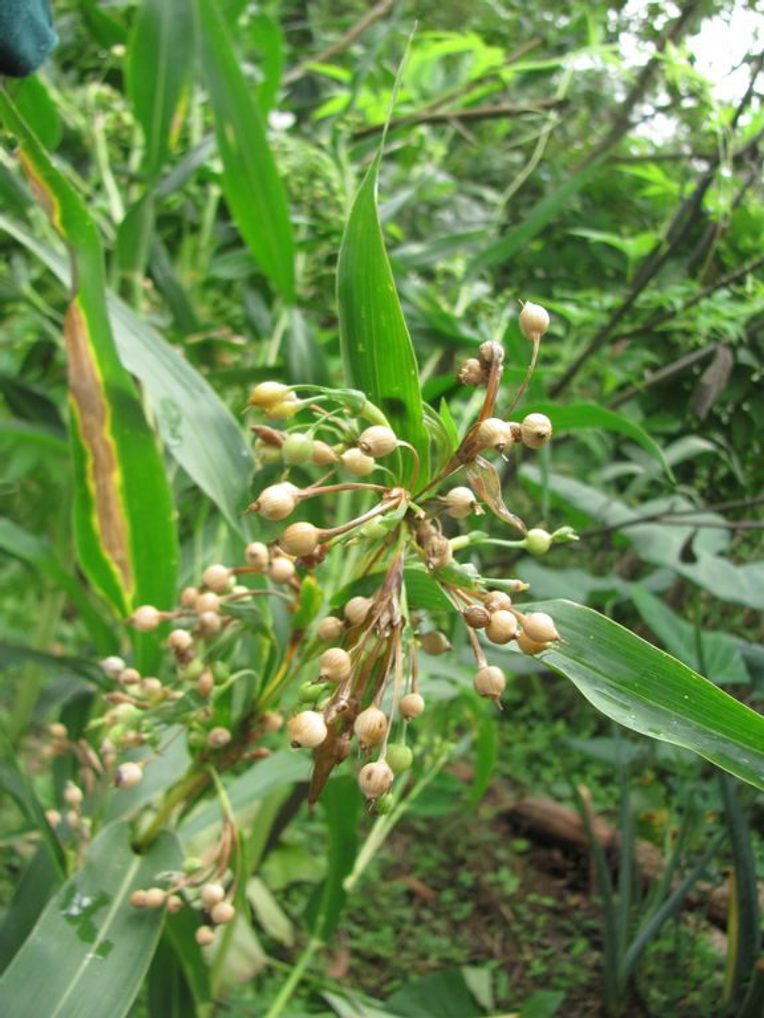
Communities became acutely aware of their mounting food, and hence economic and political, dependencies when the Revolutionary Armed Forces of Colombia (FARC-EP), the oldest and largest leftist guerrilla movement in the country, engaged in an armed strike in 1999 that cut Putumayo off from the Andean interior. During that period, foodstuffs could not be transported to the department. The guerrillas have also begun to require that communities under their territorial influence grow subsistence crops, so that they are not as vulnerable to the fluctuating market prices of coca. A central figure in the early struggles to regain regional food autonomy was a liberation theology–inspired Catholic priest in Puerto Caicedo named Padre Alcides. Up until his assassination in 1998, he gave ecological sermons, reforested the church grounds, and passed out autochthonous seeds instead of bread during Communion, among many other activities to support farmers’ gradual transition from commercial coca cultivation. Heraldo argues that seed diversity is not literally disappearing from regional ecologies, but rather that different plants, trees, medicines, and animals have disappeared from people’s mental inventories and social relations. Nor is it simply a question of idealizing the past, as many farmers who settled in the region since the 1930s engaged in unsustainable agriculture and animal husbandry. Instead, Heraldo and the other networks of farmers I mention are recovering ancestral, traditional, and popular practices, as well as implementing certain techniques they have learned from modern ecological, agroforestry, and microbiological sciences.

In the film series, Heraldo describes food security as a government’s obligation to guarantee access to quality food to all its peoples. What quality comes to signify is, of course, a disputed issue. Food sovereignty is conceived as an integral component of the protection of national sovereignty when a government has the capacity to guarantee autonomous and sustainable food production within its borders, and to safeguard the country’s resources from domination by foreign powers. More than market competitiveness, this second point speaks to the sustainability of national food production and anti-imperial legacies in Latin America. Food autonomy is described as the free determination of all communities, peoples, and farming families to produce, prepare, and consume the food that is compatible with their preferences and territorial agroecological conditions. This implies that they have autonomy (that is, collective determination) over their territories and agrarian policies.
Many practices can contribute to recovering or establishing regional food autonomy: for example, the creation of community controlled seed banks that foment agrobiodiversity; fostering solidarity-based economies between cities, towns and countryside; constructing small farmer markets that house pluralistic economic activities; eliminating dependencies on commercial inputs; reforesting; recovering recipes and innovating regional food cultures; and adopting community-designed rural life plans into public policy. The first two components of what PLADIA calls a “sustainable agroproductive farm” are food autonomy and environmental sustainability. As I argue in the article, these farms are not solely conceived of as private property with exploitable economic potential, but rather form part of an Andean-Amazonian territory. Rural families can resist being displaced from the territory when they cultivate and are cultivated by thriving selva ecologies. Inspired by political struggles to actualize alternatives to growth-oriented development and the neoextractivism that characterizes contemporary economic models across Latin America, Heraldo and other farmers refer to this as a proposal for buen vivir or bien vivir[living well; sumac kawsay in Quechua and sumaj qamaña in Aymara) rather than living better. What I characterize in the article as “recolonizing the farm with forest” and producing one’s own food, rather than becoming a dependent consumer, are material practices that begin to liberate farmers from what I referred to in my dissertation as regional agropolitiquería, which is deeply tied to the global apparatus of capitalist agribusiness and modernist logics of post–Green Revolution agricultural sciences.
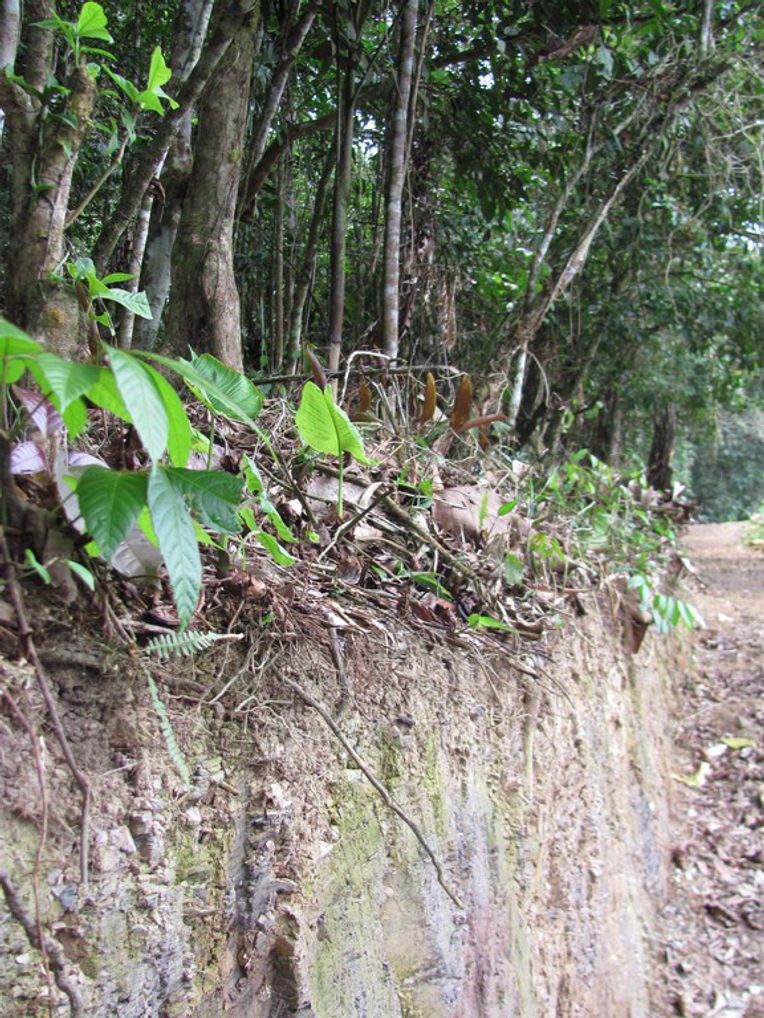
JS: I was struck by the interest and dedication to the selva floor (el suelo) as the basis for ecological practices as described both in your article and in the film series. Can you discuss the selva floor as it relates to agricultural practices?
KL: Soil scientists enlisted by the state in the 1970s to conduct the first modern national resource inventory of the Colombian Amazon, PRORADAM, were trained to work in the county’s temperate interior where soils are generally a meter deep and acquire 90 percent of their nutrients from weathered minerals stored in their uppermost horizons. In contrast, the Amazonian plains appeared to them as more litter layer than soil. Dominant scientific representations that informed state agricultural extension often depicted these soils as thin, acidic, poor, senile, and naturally limited for modern agricultural production. In this photo, you can observe the 5–10 centimeter organic layer that is characteristic of many soils in the Amazon. You can also viscerally detect the intimate and recycling interplay between soils and selva that makes soils more of a relation than a stable entity. In other words, soils can only exist if forest canopy, diverse plants, and their corresponding microbial communities exist because the perpetual relations of nutrient recycling mutually sustain selva and suelo. Instead of focusing their attention downward on the productivity of the ground (by engaging in chemical fertility tests or correcting the pH levels of soils), the farmers I learned from are attentive to what is going on up, down, and all around them. Elsewhere I have written about the ways that these practices enact chemical versus biological soils with differing political, economic, and socioecological capacities and foreclosures (Lyons 2014).
The alternative agricultural practices I discuss in the article are dispersed and heterogeneous. Some of these farmers design their gardens from east to west so that plants and trees will have the most exposure to sunlight. This augments their biomass by increasing photosynthesis and produces natural forms of fertilization when leaves fall and decompose. The farmers make sure to associate plants that have roots capable of vertically penetrating through acidic layers of clay to reach the nutrients below with other plants that have roots that splay horizontally and feed from the hojarasca. They follow the lunar cycles to determine when to plant different crops. Other families practice successional farming, which depends on temporal synchronization between the life cycles and shade provision of a sequence of plants and trees. Heraldo recommends building creeping plant gardens that climb up trestles and produce fruits, nuts, herbs, and beans every fifteen days. This is an alternative to conventional, fenced-in, ground-level gardens that require intensive tilling, chemical inputs, and resowing after a single harvest. He designs fruit orchards and reforestation processes to create natural arrangements of the macronutrients NPK. This entails sowing leguminous trees such as guamo, which fix nitrogen, with palm trees and ferns, which concentrate phosphorus, and waxy-leaved trees like plantains, which pump potassium to an underground microbial world. These diverse agricultural practices slow down dominant agricultural reason by troubling not only what it means to define a soil as productive, but also the market-oriented and ultimately human-centered notion of productivity itself.
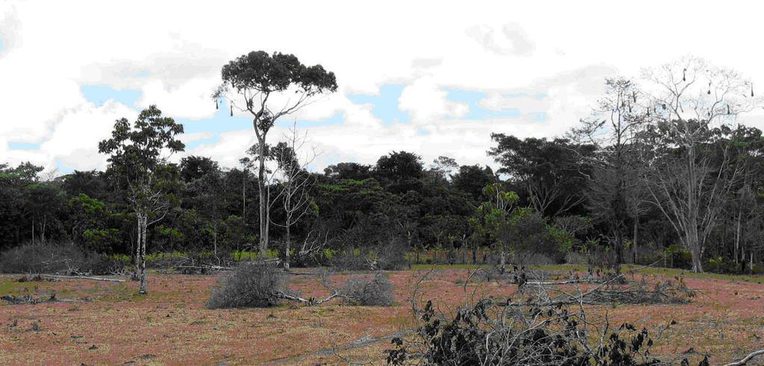
JS: In your article, you briefly mention the recent change in aerial fumigation policy in Colombia. How, if at all, do you think this change will affect your field site and the forms of precarious life that you study?
KL: One the one hand, the suspension of aerial fumigation operations using Monsanto’s glyphosate raises important questions about the future of the global War on Drugs. Longstanding policy critiques waged by diverse sectors in and beyond Colombia, including human rights and environmental NGOs, policy watch groups, lawyer’s collectives, networks of concerned scientists, community activists and social movements, and leftist political organizations, have consistently demonstrated the ineffective, economically inefficient, and unjust nature of repressive supply-side counternarcotics strategies. Proposals for decriminalization and other, more integrated approaches to drug policy gained hemispheric political traction for the first time during the VI Summit of the Americas in Cartagena, Colombia in 2012. The overall failure of the U.S.-Colombian antinarcotics policy, Plan Colombia, to provide viable alternatives to illicit crop production or to reduce violent organized crime is almost unequivocally acknowledged. This continues to open spaces for public dialogue about what a democratic reformulation of drug policy might look like in Colombia’s likely post-accord—what others call postconflict—transitional justice scenario.
On the other hand, in the rush to move forward towards a postglyphosate political moment, government officials are quick to deem aerial fumigation and its ongoing deleterious public health, environmental, and human rights impacts a thing of the past. The national government’s incremental shift towards integral antidrug approaches hinges on replacing discourses of criminality with those of vulnerability. However, vulnerability may be what Philippe Pignarre and Isabelle Stengers (2011) call an infernal alternative, which continues to treat coca growers and disputed rural frontier territories as objects of intervention in the most reductionist political sense, as problems that must be solved. Such an approach continues to overlook agrarian movements as legitimate political interlocutors participating in hard-fought struggles and ongoing popular processes to collectively determine the socioecological, political, economic, and justice-making present(s) and future(s) of their territories. Forced manual eradication continues in Putumayo and elsewhere, and some of the alternative strategies that are being proposed by the government do not stray far from the failed alternative development and crop substitution programs of the past. In addition, the government has not demonstrated a willingness to adopt coca growers’ proposals to learn from the experiences of Bolivia and Peru, where legal, state-supported economic alternatives for coca crops, such as medicines, fibers, and foodstuffs, exist. These proposals were presented during the National Agrarian and Popular Strike in 2013 and at the National Constituent Assembly of Coca, Poppy, and Marijuana Growers in Mocoa, Putumayo in July 2015.
Putumayo is, however, currently undergoing a very interesting political transition. The recently elected female governor from the Green Party (a convergence of center, center-left, and moderate conservative sectors) built alliances with the Regional Working Group of Social Organizations, which is largely composed of small-farmer organizations and unions. Heraldo Vallejo was appointed Secretary of Agriculture for the department in January, and the technical team that will support the formulation of PLADIA 2035 is currently being formed. I will return to Putumayo later this month, and I am eager to learn how the alternative agricultural practices I mention in the article will proliferate and be transformed. What kinds of politics of nature will emerge? What kind of state can an Andean-Amazonian or selva-based state become?
Further Viewing
To see more of Cultivando un Buen Vivir en la Amazonia in Spanish, you can watch the video clips below:
Los Retos de Producir en la Amazonia (The Challenges to Producing in the Amazon)
Plan Integral de Desarrollo Andino-Amazónico (PLADIA; Andean-Amazonian Integral Development Plan)
Ordenamiento de la Finca Agroproductiva (Organization and Design of the Agroproductive Farm)
La Huerta Amazónica (The Amazonian Garden)
La Huerta de Enredaderas (The Creeping Plant Garden)
Huerto Amazónico de Frutales (Amazonian Fruit Orchard)
Seguridad, Soberania, y Autonomía Alimentaria (Food Security, Sovereignty and Autonomy
References
Lyons, Kristina. 2014. “Soil Science, Development and the ‘Elusive Nature’ of Colombia’s Amazonian Plains.” Journal of Latin American and Caribbean Anthropology 19, no. 2: 212–36.
Pignarre, Philippe, and Isabelle Stengers. 2011. Capitalist Sorcery: Breaking the Spell. Translated by Andrew Goffey. New York: Palgrave Macmillan.
Tsing, Anna. 2015. The Mushroom at the End of the World: On the Possibility of Life in Capitalist Ruins. Princeton, N.J.: Princeton University Press.